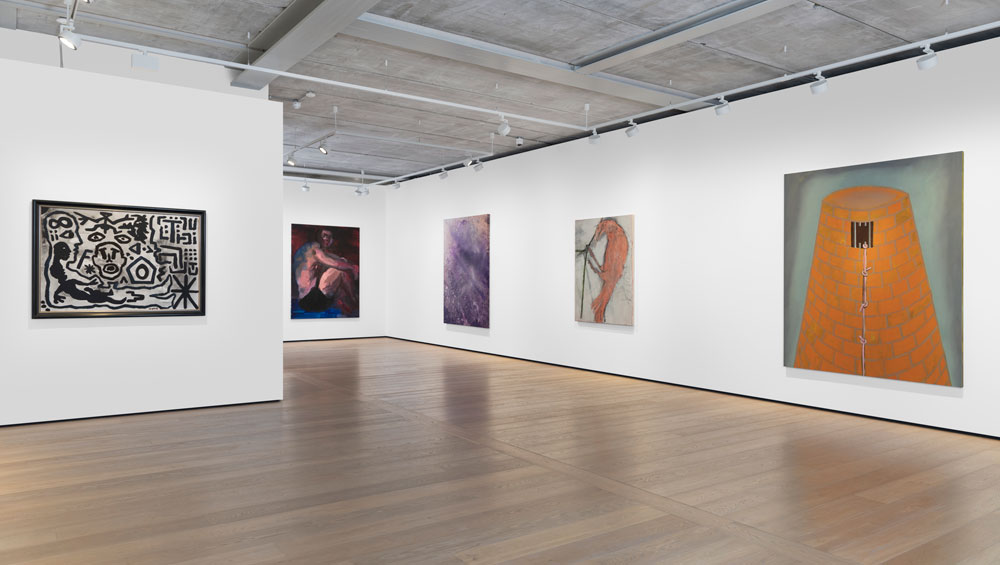
Almine Rech Gallery, London
2 October – 17 November 2018
by ANNA McNAY
In 1981, the Royal Academy of Arts, London, hosted a seminal presentation of 20th-century painting, co-curated by Norman Rosenthal, Christos M Joachimides and Nicholas Serota. At a time when the relevance of figurative painting was in question, these three white male curators put together an equally all-male exhibition, comprising more than 150 works by 38 established and emerging artists, arguing persuasively that there was life in the old dog yet – and, moreover, that an old dog could be taught new tricks. Alongside older generation painters, such as Francis Bacon, Willem de Kooning and the godfather of modern painting, Pablo Picasso, the exhibition introduced a number of young unknowns, including Francesco Clemente and Gerhard Richter.
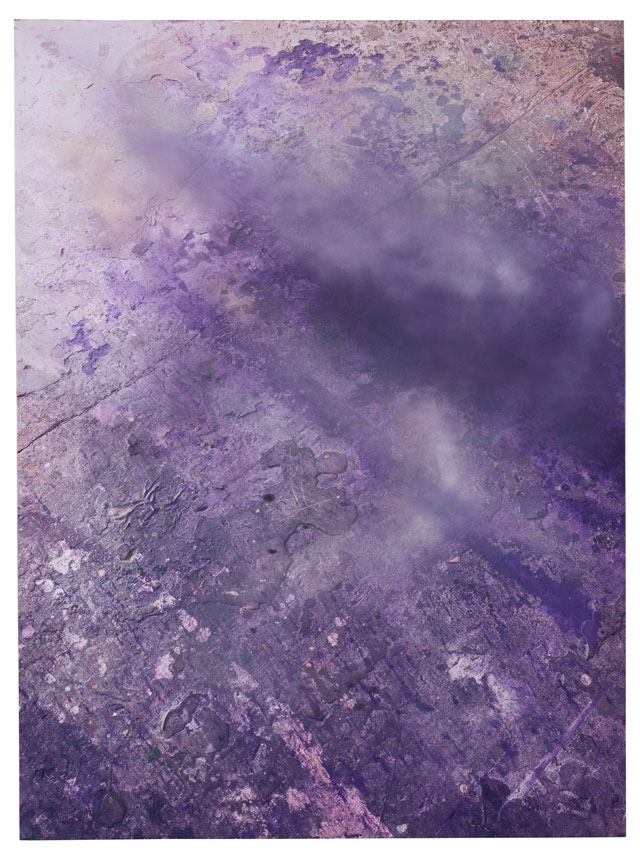
Julian Schnabel, Ascension IV, 2015. Inkjet print, ink and spray paint on polyester, 213.4 x 158.8 x 5.1 cm. Photo: Argenis Apolinario.
Now, nearly four decades later, Rosenthal has curated an, albeit significantly condensed, follow-up, revisiting this defining moment in his curatorial career, and re-posing the still-pertinent question about the relevance of painting in an art world so dominated by the conceptual, multimedia, and, increasingly, the virtual. This time, 15 artists have been selected, 13 of them from the original roll call, with two women – Maria Lassnig and Susan Rothenberg – added, Rosenthal says, as a “kind of apology” and to redress the balance (if two out of 15 can be said to do that!).1 Apart from Picasso’s L’Homme au chapeau de paille (1964), all the works have been made since the first exhibition ended (in fact, all but his and Lassnig’s, since 2000).
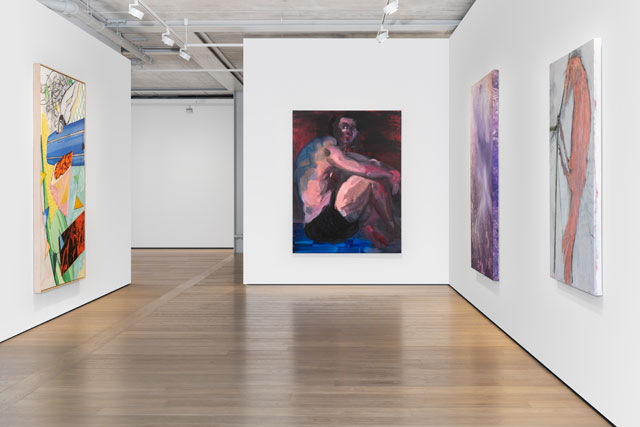
Almine Rech Gallery, A New Spirit Then, A New Spirit Now, 1981-2018, installation view.
In the preface to the original exhibition, the curators wrote: “A group exhibition is by its very nature an anthology. But it can also achieve much more, for exhibitions introduce the concept of time into the process of looking at pictures … The exhibition thus becomes almost an artwork in itself.”2 Certainly, with the context of this preceding show, time cannot help but be a factor one bears in mind when visiting this new iteration – especially salient in the case of artists such as Clemente and Richter, both included again here, who are now heavyweights of the art world, offering proof that painting is not only alive and well but thriving – and surviving – across the years.
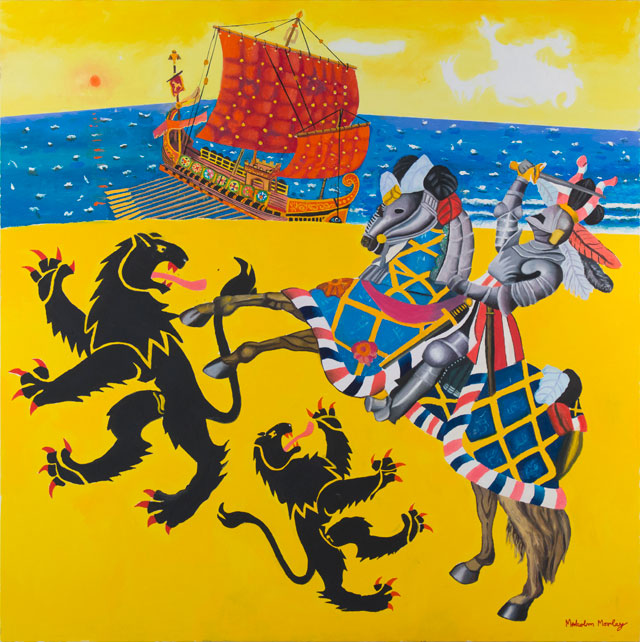
Malcolm Morley, St. George and the Dragon, 2016. Oil on linen, 132 x 132 cm (framed). Photo: Robert Vinas, Jr.
The idea of the exhibition as an artwork in and of itself also bears out, particularly with the thoughtful hang, which leads the visitor around, almost narrating a story of influence, drawing similarities and differences, from one work to the next, in terms of style, colour and content. So, for example, the exhibition opens with two bright yellow canvases by Malcolm Morley, who settled permanently in New York in 1958 and developed a style influenced by the abstract expressionists. These two works, however, are resolutely figurative, depicting knights in armour on horseback, shooting arrows, and, hung in the first room of the gallery, so that they seemingly stand guard like sentries, ushering the visitor in, and, as Morley was the winner of the first Turner Prize in 1984, herald this new age of painting.
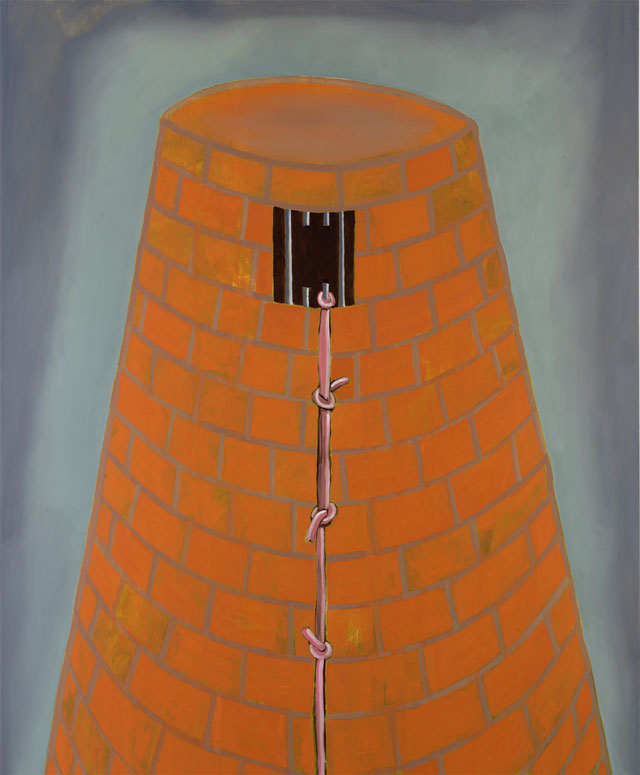
Francesco Clemente, Tower of Song, 2017. Oil on canvas, 221 x 181 cm. Courtesy of the Artist and Almine Rech Gallery. Photo: John Berens.
The German neo-expressionist Markus Lüpertz, in the next gallery space, takes an Old Master work by Nicholas Poussin and contemporises it, again celebrating a new approach, while firmly staking his place in the art historical and painterly lineage. Next to him hangs the Picasso, flanked on its other side by Frank Auerbach’s ghostly David Landau Seated (2013-15), echoing the full-frontal portrait composition of Picasso, but abstracting still further, to the point where the figure seems to be being swallowed into the mauve ground. Beyond this, Howard Hodgkin’s Hello and Goodbye (2014-15) offers but a mere suggestion of a physical presence, with strong sweeping brushstrokes across a wooden diptych, arguably purely abstract, but, as Paul Moorhouse, the curator of the National Portrait Gallery’s recent exhibition Absent Friends (2017), proposed in his foreword to the accompanying catalogue, Hodgkin’s pictures “evoke friends of the artist not as they are observed, but rather as they appear in memory. Divested of distracting details, the figures have assumed an essential form that belongs to the mind’s eye.”3
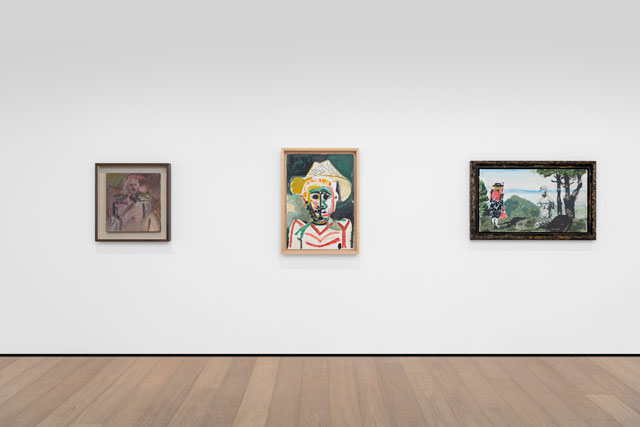
Almine Rech Gallery, A New Spirit Then, A New Spirit Now, 1981-2018, installation view.
AR Penck’s black-and-white Plato, Sokrates und Aristoteles – 6 (1996) is figurative, but almost in a primitive way, recalling the style of cave painting, and Lassnig’s pastel-coloured Samson (1983) draws on similarly classical – or, in this instance, biblical – imagery, perhaps here with a tongue-in-cheek aside to the strength and power of women. Even more ironic is the fact that Lassnig is followed directly by a work by Georg Baselitz, who, in 2013, told a reporter from the German news magazine Der Spiegel: “Women don’t paint very well.”
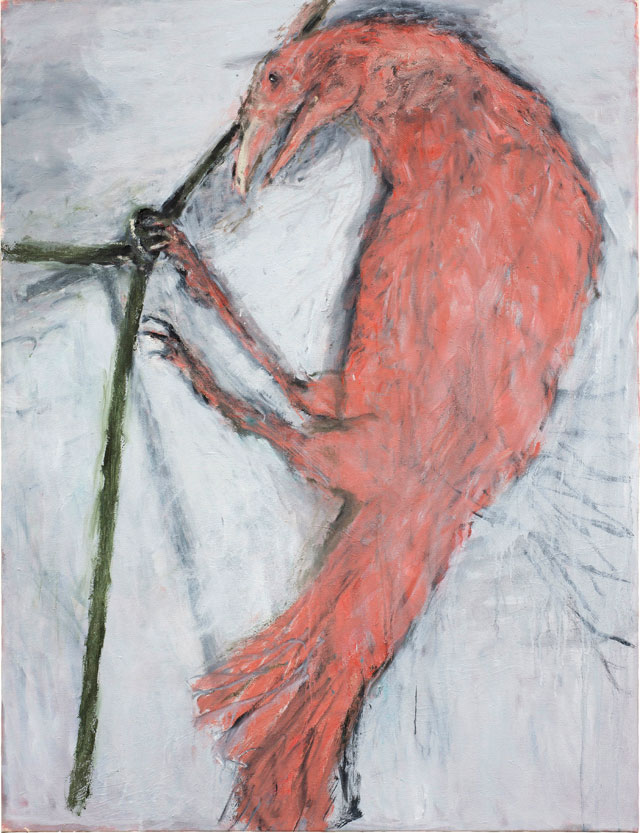
Susan Rothenberg, Pink Raven, 2012. Oil on canvas, 159 x 122 cm. Photo: James Hart.
Rothenberg’s Pink Raven (2012) picks up on the opening idea of guards of the medium, while also being a symbolic bird associated with Apollo, the god of prophecy, and thus looking forward to what is to come. The final canvas, Prophet at the Sea of Galilee (2007), by Rainer Fetting, repeats this objective, consolidating the idea, again put forward in the original catalogue, that the exhibition be seen both as a reflection on the state of painting now, but also as a manifesto.4 As Joachimides wrote in the concluding statement to his essay for the 1981 catalogue: “Together the artists gathered here invite us to see things with a fresh eye, to share a vision that reveals new relationships between art and reality, between the painted image and human endeavour.”5 And these acts of revelation, and of new ways of understanding and of seeing, are surely the core values of art of any kind, most readily and immediately mediated by painting, a practice that, for all the questioning and doubting, will never lose its substance or worth. This small but wonderfully lively and well-curated exhibition is a reminder of this.
References
1. At the time, not specifically referring to women artists, the curators wrote: “Omissions we feel are justified in the context of an exhibition which suggests so many different possibilities, so many different approaches, both of subject and of the manner of painting.” A New Spirit in Painting, exhibition catalogue, Royal Academy of Arts, London, 1981, page 12.
2. Ibid, page 11.
3. Howard Hodgkin: Absent Friends, exhibition catalogue, National Portrait Gallery, London, 2017, page 10.
4. A New Spirit in Painting, exhibition catalogue, op cit, page 11.
5. Ibid, page 16.